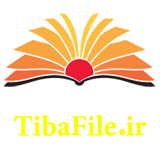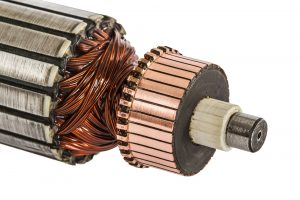تشخیص عیوب الکتریکی در ماشین القایی
تشخیص عیوب الکتریکی در ماشین القایی
تشخیص عیوب الکتریکی در ماشین القایی
حجم فایل : ۲٫۹۴۹KB
تعداد صفحه : ۱۳صفحه
قیمت فایل : رایگان
فرمت فایل: PDF
تشخیص عیوب الکتریکی در ماشین القایی
Advanced Diagnosis of Electrical Faults in Wound-Rotor Induction Machines
Abstract
The aim of this paper is to present a diagnosis methodology for the detection of electrical faults in three-phase wound-rotor induction machines (WRIMs). In the considered
application, the rotor windings are supplied by a static converter for the control of active and reactive power flows exchanged between the machine and the electrical grid.
The proposed diagnosis approach is based on the use of wavelet analysis improved by a preprocessing of the rotor-voltage commands under time-varying conditions. Thus, the time evolution of fault components can be effectively analyzed.
This paper proves also the importance of the fault components computed from rotor voltages in comparison to those coming from rotor currents under closed-loop operation. A periodical quantification of the fault, issued from the wavelet analysis, has been introduced for accurate stator- or rotor-fault detection.
Simulation and experimental results show the validity of the proposed method, leading to an effective diagnosis procedure for both stator and rotor electrical faults in WRIMs.
I. INTRODUCTION
NOWADAYS, for modern wind power generation systems, the use of wound-rotor induction machines (WRIMs) is a well-established technology. Among different alternatives for variable-speed–constant-frequency (VSCF) generation systems, the WRIM can provide a high energy output with a low rating of the power converter connected to the rotor side.
In this type of application, monitoring theWRIM is crucial to ensure the maximum availability of wind energy for the power grid. Investigations on different failure modes in variable-speed induction machines have revealed that 45% of motor failures are related to the stator and rotor parts [1].
Some faults are not destructive and evolve from an incipient stage to a more severe condition. Specifically, each electrical fault that occurs in both stator and rotor sides of a WRIM, such as resistance variations or short circuits, produces a phase dissymmetry because the phase impedances are no longer equal [2]
. The increase in a phase resistance, commonly referred to as “high-resistance connection” in the literature, is a common problem that can occur in any power connection of industrial electrical machines [2]–[۴]. Operating in aggressive environments offshore or onshore, winding connections of WRIMs are subjected to corrosion, abrasion, and fretting, leading generally to local heating, which can propagate the insulation damages [5]–[۷].
Consequently, the detection of the first anomalies, such as resistance changes and winding imbalances, can prevent serious damages from happening and avoid longer downtime periods.
Different diagnostic methods have been proposed for WRIM [8], [9]. In particular, some authors have developed a comprehensive diagnostic technique based on the Fourier analysis (FA) of the rotor-voltage set points at constant speed [8]. Unluckily, induction machines operate mostly in time-varying conditions.
In this context, slip and speed vary unpredictably, and the classical application of FA for processing the voltage set points or the measured currents fails, as shown in [10]–[۱۲]. In fact, the bandwidth of the fault frequency components is related to the speed variation. Among different solutions, the signal demodulation [10], the high-resolution frequency estimation [13], and the discrete polynomial-phase transform [14] have been developed to reduce the effect of the nonperiodicity of the analyzed signals or to detect multiple faults [15]. These FA-based techniques give high-quality discrimination between healthy and faulty conditions, but they cannot provide any timedomain information.
This shortcoming in the FA-based techniques can be reduced by analyzing a small interval of the signal by means of the short-time Fourier transform. This method has been widely
used to detect both stator and rotor failures in induction motors.
However, the fixed width of the window and the high computational cost required to obtain a good resolution still remain major drawbacks of this technique [16]–[۱۸]. Based on the instantaneous frequencies issued from the intrinsic mode functions, the Hilbert–Huang transform was proposed formotor diagnosis and has shown quite interesting performances in terms of fault severity evaluation [19]–[۲۲].
Other quadratic transforms, such as the Wigner–Ville distribution (WVD), suffer from the same constraint [23]. This limitation can be overcome by new advanced time–frequency distributions such as smoothed pseudo-WVDs [23], Choi–Williams distribution [23], [24], and Zhao–Atlas–Marks distribution [25]. However, the removal of cross-terms leads generally to reducing the joint time–frequency resolution and the signal energy.
دانلود فایل ترجمه
تشخیص پیشرفته نواقص و عیوب الکتریکی در ماشینهای القایی با روتور (حلقه) لغزان
تشخیص نواقص الکتریکی
حجم فایل ترجمه : ۱٫۶۱KB
تعداد صفحه ترجمه : ۲۷ صفحه
قیمت فایل ترجمه : ۲۱۰۰۰ هزار تومان
تشخیص عیوب الکتریکی در ماشین القایی
تشخیص عیوب الکتریکی در ماشین القایی
تشخیص عیوب الکتریکی در ماشین القایی
- قیمت محصول: 0 تومان
- تعداد صفحه: 13صفحه
- فرمت: PDF
- حجم فایل: 2.949KB


 تشخیص دقیق شکستگی میله روتور براساس آنالیز مدولاسیون
تشخیص دقیق شکستگی میله روتور براساس آنالیز مدولاسیون ۵۰۹۴۱۰۴۳۸۳۰
۵۰۹۴۱۰۴۳۸۳۰ ۵۰۹۴۱۰۴۳۷۴۳
۵۰۹۴۱۰۴۳۷۴۳ آنالیز SSR براساس مدل امپدانس
آنالیز SSR براساس مدل امپدانس